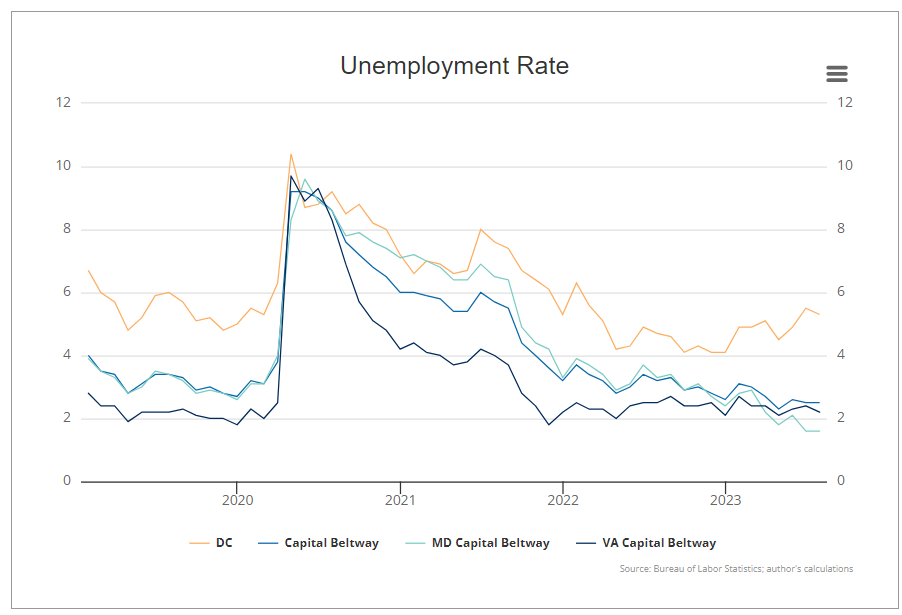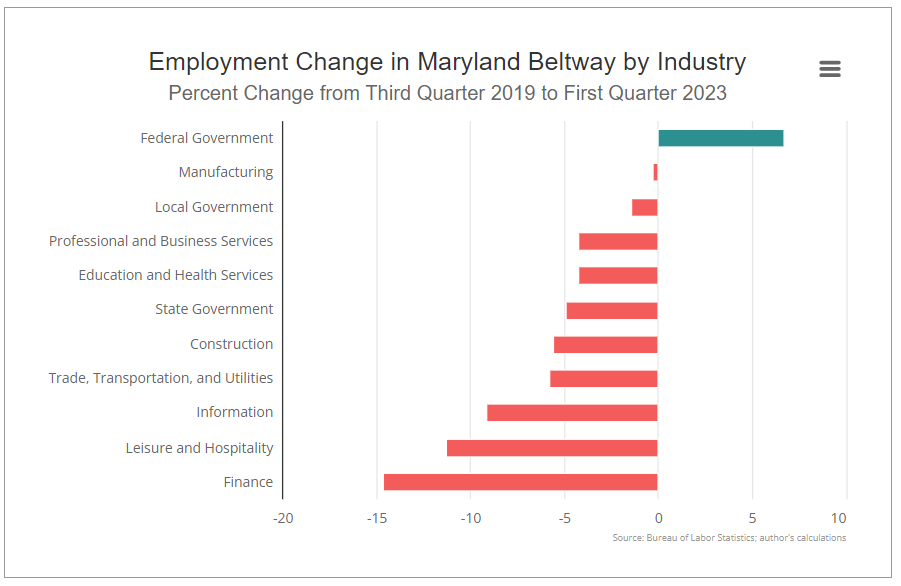Adam Scavette and Keith Waters
This article is a collaboration between the Federal Reserve Bank of Richmond and the Stephen S. Fuller Institute at the Schar School at George Mason University.
See Richmond Federal Reserve for Interactive Article
Introduction
The District of Columbia and its inner ring suburbs — referred to as the Capital Beltway after Interstate 495 — has historically been the core job center for the Washington Metropolitan Area1. (See map below.) Following restrictions to in-person activities at the onset of the COVID-19 pandemic in spring 2020, unemployment spiked within the Capital Beltway, jobs were shed, and commuting patterns shifted. The labor market recovery from the pandemic shock has been uneven within the Capital Beltway, with stronger growth in the Virginia suburbs than the District of Columbia and Maryland’s Beltway counties. In this article, we look at labor market activity within the Capital Beltway over the past three years to assess what might be contributing to the slower growth north of the Potomac River.

Unemployment Rate Is Lowest in Maryland Capital Suburbs Amid Shrinking Labor Force
Following the onset of the COVID-19 pandemic, the unemployment rate inside the Capital Beltway spiked from historically low rates of around 3 percent in 2019 and early 2020 to 9.2 percent in April 2020. After the unprecedented increase, unemployment quickly began declining, returning to 3.2 percent by December 2021, and declining to just 2.5 percent by July 2023. As a whole, the Capital Beltway has returned to a historically low unemployment rate, but the Maryland and Virginia portions have fared better than D.C. proper: In July, the unemployment rate in the Maryland portion was at a 20-year low of just 1.6 percent, while Virginia’s share had an unemployment rate of 2.2 percent. In contrast, D.C. proper had an unemployment rate of 5.3 percent — a rate that has been steadily rising since December 2022.

Although the Maryland portion of the Capital Beltway recorded a two-decade low unemployment rate in July, this unfortunately has largely been driven by a reduced labor force, not by rising employment. The labor force in the Maryland Beltway contracted 3.4 percent between January 2020 and July 2023 (about 37,000 people), which was consistent for Montgomery County and Prince George’s County. In contrast, the labor force in the Virgina Beltway expanded 5.8 percent over the same period — again roughly evenly among jurisdictions in the Virginia portion. The labor force in the District of Columbia contracted 1 percent over the same period.

Employment Growth Slower in Maryland Suburbs
As the unemployment rate in the Capital Beltway spiked during the height of the pandemic, employment in the Capital Beltway rapidly contracted. Employment in the Capital Beltway declined by 295,000 workers from 2.54 million in the fourth quarter of 2019 to 2.23 million in the second quarter of 2020. Figure 3 below illustrates how all three sub-state regions have yet to return to pre-pandemic employment levels, and the Maryland Beltway remains farthest from its pre-pandemic level.

Disaggregating the jurisdictions reveals that employment change in the Virginia Beltway varies far more than in the Maryland portion. From the fourth quarter of 2019 to the first quarter of 2023, employment decreased 10.8 percent in Alexandria City while it increased 15 percent in Fairfax City. Meanwhile, the components of the Maryland Beltway — Montgomery County and Prince George’s County — declined by roughly similar percentages. Among the three largest jurisdictions in the Capital Beltway (District of Columbia; Fairfax County, Virginia; Montgomery County, Maryland), Montgomery County recorded the largest percentage decline, despite being smaller in level terms than the District of Columbia. Notably, employment losses in Montgomery County accounted for 26 percent of losses for the entire state of Maryland over this period, even though it only accounted for 17.5 percent of the state’s employment in the fourth quarter of 2019. In fact, the Maryland Beltway accounted for 41.8 percent of Maryland employment losses over the period.

Firm Growth in Maryland Capital Suburbs Slower Than Rest of the State and Capital Beltway
Growth in labor demand resulting from private sector establishment growth is another force underlying the varying sub-state performances of the Capital Beltway. In the 16 years prior to the pandemic, the number of establishments increased 10.9 percent in the Maryland Beltway, 25.6 percent in the Virginia Beltway, and 42.8 percent in D.C. proper. As the region has recovered from the pandemic, establishment growth increased notably in the Virginia Beltway and D.C. proper but remained relatively muted in the Maryland Beltway. From the fourth quarter of 2019 to the first quarter of 2023, the number of establishments increased 17.8 percent in the Virginia Beltway and 19 percent in D.C. proper, which compare favorably to the growth of just 3.3 percent in the Maryland Beltway. The overwhelming majority of establishment growth in the capital region over the last two decades occurred in the District of Columbia and the Virginia Beltway. In fact, while the number of establishments in the Capital Beltway increased by 47,948 establishments from 2003 to 2023, the share of the increase in the Maryland Beltway was just 16.6 percent.

Post-pandemic establishment growth in Prince George’s County and Montgomery County are not only lagging peer jurisdictions in the Capital Beltway, but establishment growth is lagging the state of Maryland as a whole. From the fourth quarter of 2019 to the first quarter of 2023, the number of establishments increased 2.4 percent in Montgomery County, 5.1 percent in Prince George’s County, and 6.8 percent in the state of Maryland. While the Maryland Beltway accounted for 30.2 percent of Maryland establishments in the first quarter of 2003, it accounted for only 27.3 percent of Maryland establishments in the first quarter of 2023.

Maryland Beltway’s Post-Pandemic Employment Losses Are Concentrated in Leisure and Hospitality
Given that the economy of the Maryland Beltway is underperforming the Capital Beltway overall as well as the state of Maryland, it is important to identify which industries have been driving the underperformance. The three industries in the Maryland Beltway with the largest percentage declines pre-pandemic include finance (-14.6 percent), leisure and hospitality (-11.3 percent), and Information (-9.1 percent). Together, these three sectors accounted for 46.1 percent of total employment losses in the Maryland Beltway. The leisure and hospitality sector recorded the largest total employment loss over the period (-9,050 jobs), accounting for 25.8 percent of employment losses. The trade, transportation, and utilities sector (-6,930) and the professional and business services sector (-6,160) recorded the second and third largest employment declines. Losses in both the trade, transportation, and utilities sector, as well as the professional and business services sector are concerning for the Maryland Beltway as both sectors have recorded robust growth elsewhere. Furthermore, the professional and business services sector remains the base of economic activity in the Capital Beltway.

Conclusion
The post-pandemic labor market recovery has been uneven within the Capital Beltway as Virginia suburbs have made more headway than those in Maryland. In Maryland’s Beltway suburbs, the shrinking labor force has created a tighter labor market, despite slower growth in the number of business establishments. Not unlike the nation, the area’s post-pandemic job losses have been concentrated in the leisure and hospitality sector; however, the recovery in the Maryland suburbs has been slow even in those industries, such as trade/transportation/utilities and professional and business services, that have driven the recovery in other parts of the region and the country.
1 – For the purposes of our analysis, the Capital Beltway includes the District of Columbia, the Maryland Beltway (Montgomery and Prince George’s counties), and the Virginia Beltway (Alexandria City, Arlington County, Fairfax City, Fairfax County, Falls Church City).
